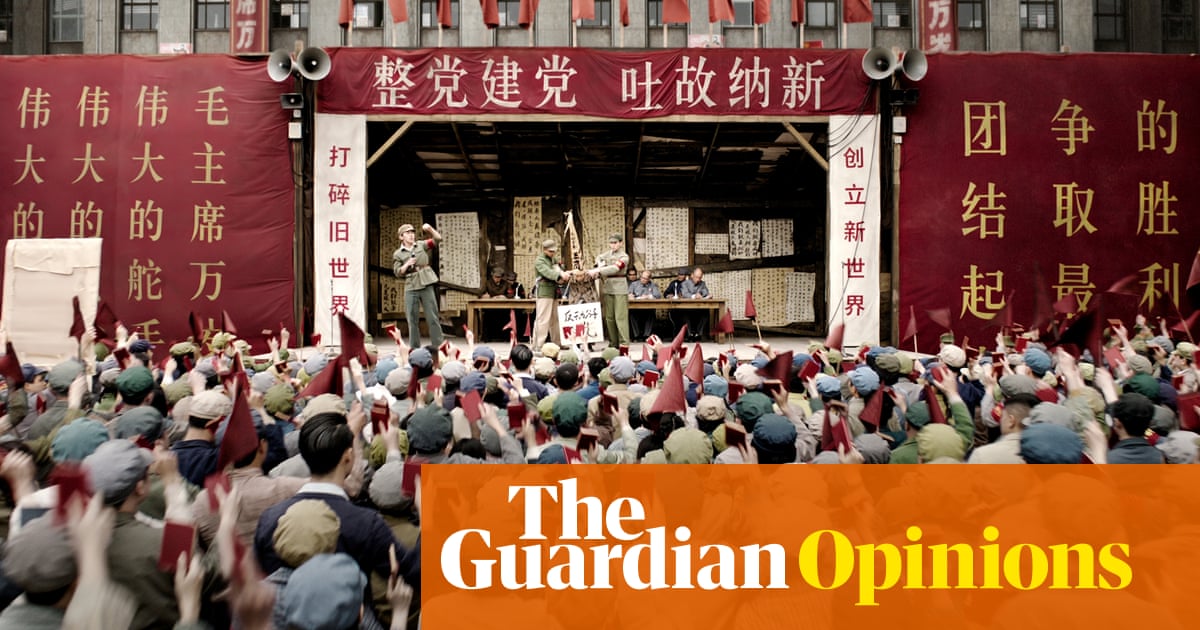
It has brain-bending physics, mysterious visitors and futuristic technology. Yet viewers of the new Netflix sci-fi epic 3 Body Problem could be forgiven for some confusion as its opening scenes unfold. A drama about coming contact with aliens catapults us back to China in 1966, at the height of the Cultural Revolution: we see an eminent physicist viciously attacked by zealots before a howling crowd. As incongruous as it seems, this moment is central to understanding the book on which the show is based.
Liu Cixin’s The Three-Body Problem has been a multimillion-seller at home and abroad, earning praise from Barack Obama and others. The show takes liberties with the author’s text, replacing key characters with multiracial friends who studied physics together at Oxford to make it more “global” (read: more western). That’s annoyed many in China, despite Liu’s blessing. But the show is strikingly faithful to the historical scenes – and those scenes point to the lasting impact of this pivotal moment in China’s history.
The decade-long Cultural Revolution was a time of extraordinary violence and unpredictability: an estimated two million people died, from top political leaders to infants. Tens of millions more were hounded. In the early stages, Red Guards – often teenage boys and girls – beat victims to death. Revered scholars were prime targets. Some family members watched helplessly as victims suffered (like the physicist’s daughter); others betrayed their parents or spouses under pressure (like his wife). 3 Body Problem captures the sadism in its specific details, down to the humiliating dunce caps placed on victims’ heads and the excruciatingly painful “airplane” position that they were forced into: bent double with arms held out behind them.
The scene is central to the story that unfolds over Liu’s trilogy of novels. But it is more than just a way to drive the plot, or to humanise a key character. Liu grew up in the Cultural Revolution. As a young child, he was sent away to grandparents when his parents’ workplace was engulfed by fighting between warring factions.
Survivors I have met remain deeply scarred by what they witnessed, what was done to them and what they did to others. Those years bred profound cynicism and fear. The sense of an individual’s puniness against vast forces, and of an apparently hopeless existential struggle; an awareness of impossible moral choices; profound pessimism about human nature; a fixation on the importance of reason; the idea that speech is dangerous – all of these themes within Liu’s work are preoccupations shared by others who lived through the era. In the world he depicts, characters discover that generosity and humanity may not merely be irrelevant, but actively threatening to the one thing that counts – survival – as the scholar Chenchen Zhang discusses in a perceptive essay exploring why rightwing nationalists are among those who have embraced his work.
In the Chinese text, however, the historical scenes appear partway through: Liu has said that his publishers feared censors would take exception otherwise. While the Cultural Revolution is not utterly taboo in China, it is highly, and increasingly, sensitive. And neither the book nor the Netflix series refer to the movement’s origins: it was unleashed by Mao Zedong to reassert his political supremacy and, secondarily, to remould the people. Without that crucial context, which would not be tolerated in China, the Cultural Revolution is just a story of youthful fanaticism, human unreason and weakness.
Liu’s depiction of a civilisation alternating between stable and chaotic eras also evokes the widely shared fear of turmoil left by the events of the Sixties, ironically fostered by the party as a way of defending the political status quo. (He told one interviewer that “if China were to transform into a democracy, it would be hell on Earth”.) But instability and fragmentation are persistent anxieties throughout Chinese history, and in many ways the most obvious parallel for Liu’s central conflict is the confrontation between 19th century Qing dynasty China and the imperial powers whose advanced militaries allowed them to carve it up. What China calls the “century of humiliation” began with Britain and the opium wars and concluded with the end of the brutal Japanese occupation in 1945. Many Chinese readers also see an allegory of their country’s current struggle with the US as the two battle for technological superiority.
Chinese writers have addressed contemporary concerns through sci-fi for over a century. Like historical fiction, it allows them greater latitude, especially at a time of more stringent censorship. Of course, it does novelists a disservice to treat their work as a cypher: Liu stresses he is not using fiction to disguise a critique of the present. He is truly passionate about science – as his dense technical passages make clear – and has lived through extraordinary leaps in knowledge; he compares China’s recent flourishing in sci-fi to the “golden age” of the genre in America, where scientific innovations spurred authorial invention.
But while fiction doesn’t simply encode the real world, it does reflect and refract its concerns. (The book’s reiterated theme of ecological despoliation also makes the climate crisis loom large for the reader). Liu has written, of the Cultural Revolution and other childhood experiences, that “In this book, a man named ‘humanity’ confronts a disaster, and everything he demonstrates in the face of existence and annihilation undoubtedly has sources in the reality that I experienced.” His trilogy is rooted in the events of 1966, even as it stretches into a distant future.
Tania Branigan is foreign leader writer for the Guardian and author of Red Memory: The Afterlives of China’s Cultural Revolution












